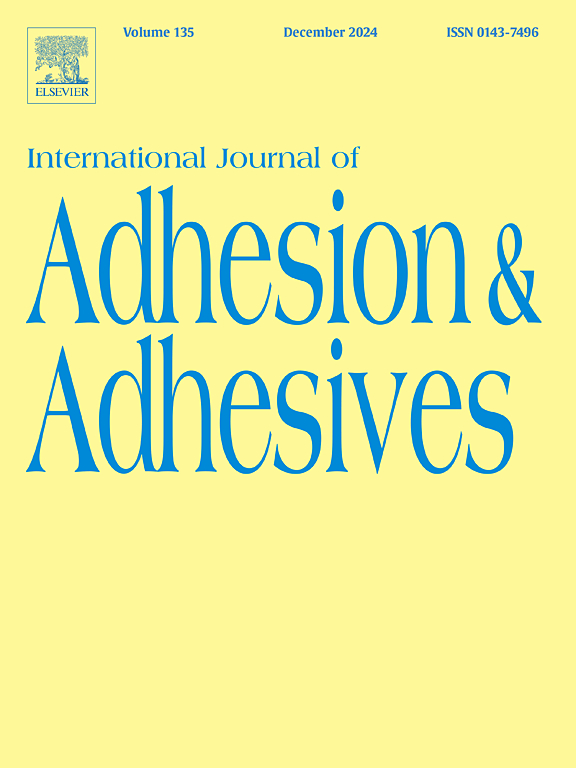Preheated composite resins versus luting cement: Degree of conversion, film thickness, color stability and bond strength to enamel and ceramic veneers
IF 3.2
3区 材料科学
Q2 ENGINEERING, CHEMICAL
International Journal of Adhesion and Adhesives
Pub Date : 2024-11-29
DOI:10.1016/j.ijadhadh.2024.103895
引用次数: 0
Abstract
Purpose
The literature is scarce regarding the use of preheated composite resin for cementing dental ceramic veneers. The purpose of this study is to evaluate the effect of using preheated composite resins as cementing agents on the degree of conversion, film thickness, color stability and bond strength of dental ceramic veneers.
Material and methods
Three composite resins, Filtek Z100 (Z100), Opus Bulk Fill APS (Opus) and Viscalor Bulk (Viscalor) were preheated and compared with Opus Bulk Fill Flow APS (Opus Flow) and resin cement RelyX Veneer (RelyX). The properties of degree of conversion, film thickness, color stability and microshear bond strength were tested. Statistical analysis was performed using ANOVA and Holm-Sidak tests (α = 0.05).
Results
The Opus Flow showed a higher degree of conversion compared to Z100 and Viscalor (P < 0.05), but similar to Opus and RelyX. The film thickness of all preheated resins was greater than the film thickness of the flow resin and the resin cement (P < 0.001). In the enamel surface, the bond strength of Viscalor was superior to RelyX (P < 0.001). In the ceramic surface, the bond strength of preheated resins was superior to the resin cement (P < 0.05). Color stability was significantly influenced by the time factor (P < 0.05), but there was no difference between the different materials (P > 0.05). There was no difference between the storage time of 30 days and 6 months.
Conclusions
The preheated composite resins showed a degree of conversion and color stability similar to the resin cement, but its film thickness was greater than the resin cement and the flowable resin. Viscalor showed the highest bond strength to enamel.
Clinical implications
Although preheated resins present similar characteristics to resin cements and flowable composite resins, the film thickness of preheated composite resins is high, which can lead to failures in the adaptation of dental ceramic veneers or even the fracture of the dental ceramic veneer during its cementation.
预热复合树脂与胶凝水泥:转化程度、膜厚、颜色稳定性和与搪瓷和陶瓷贴面的结合强度
目的利用预热复合树脂对牙体烤瓷贴面进行粘接,目前文献报道较少。本研究的目的是评价使用预热复合树脂作为胶结剂对牙科陶瓷贴面的转化程度、膜厚度、颜色稳定性和结合强度的影响。材料与方法对Filtek Z100 (Z100)、Opus Bulk Fill APS (Opus)和Viscalor Bulk (Viscalor)三种复合树脂进行预热,并与Opus Bulk Fill Flow APS (Opus Flow)和树脂水泥RelyX Veneer (RelyX)进行比较。测试了转化度、成膜厚度、颜色稳定性和微剪切粘接强度等性能。统计学分析采用方差分析和Holm-Sidak检验(α = 0.05)。结果Opus Flow与Z100和Viscalor (P <;0.05),但与Opus和RelyX相似。所有预热树脂的膜厚均大于流动树脂和树脂水泥的膜厚(P <;0.001)。在牙釉质表面,Viscalor的结合强度优于RelyX (P <;0.001)。在陶瓷表面,预热树脂的粘结强度优于树脂水泥(P <;0.05)。颜色稳定性受时间因素影响显著(P <;0.05),但不同材料间无差异(P >;0.05)。贮藏时间30天与6个月无显著差异。结论经预热的复合树脂具有与树脂水泥相似的转化度和颜色稳定性,但其成膜厚度大于树脂水泥和流动树脂。Viscalor与牙釉质的结合强度最高。虽然预热树脂具有与树脂胶结剂和可流动复合树脂相似的特性,但由于预热复合树脂的膜厚较大,可能导致牙陶瓷贴面的适应失败,甚至导致牙陶瓷贴面在固接过程中断裂。
本文章由计算机程序翻译,如有差异,请以英文原文为准。
求助全文
约1分钟内获得全文
求助全文
来源期刊

International Journal of Adhesion and Adhesives
工程技术-材料科学:综合
CiteScore
6.90
自引率
8.80%
发文量
200
审稿时长
8.3 months
期刊介绍:
The International Journal of Adhesion and Adhesives draws together the many aspects of the science and technology of adhesive materials, from fundamental research and development work to industrial applications. Subject areas covered include: interfacial interactions, surface chemistry, methods of testing, accumulation of test data on physical and mechanical properties, environmental effects, new adhesive materials, sealants, design of bonded joints, and manufacturing technology.
 求助内容:
求助内容: 应助结果提醒方式:
应助结果提醒方式:


